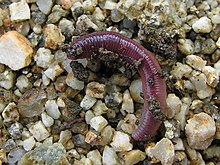
Back Erdwurm Afrikaans Regnwyrm ANG دودة الأرض Arabic دودة الارض ARZ কেঁচু Assamese Kinepikocic ATJ Sillq'u Aymara یئرقوردو AZB Nyulati BAN Alolonti BCL

An earthworm is an invertebrate animal with a long, stretchy body and no legs. It is a type of annelid.
There are 5,500 known species of earthworms in 21 families. They are found everywhere, except in polar or dry climates. Their sizes vary: they can be between two centimeters and about three meters in length. The biggest known earthworm is the giant Gippsland earthworm, found in Australia. It is usually about 80 cm in length, but can grow to about 3 meters.
The most common earthworm (in Europe, and most other temperate climate regions) grows to a size of about 20–25 cm when extended.
Most earthworms can regrow lost segments, assuming the worm has not had too much damage. This capability varies by species.
Long ago, all animals looking like worms were lumped together by John Ray and by Linnaeus in their classifications. Later, biologists found that some were in quite different groups. Roundworms and flatworms are different phyla. Inchworms are a type of caterpillar, and the slow-worm is a legless lizard.